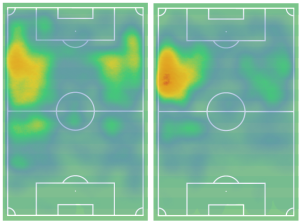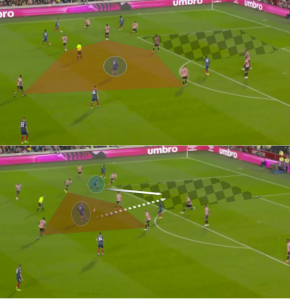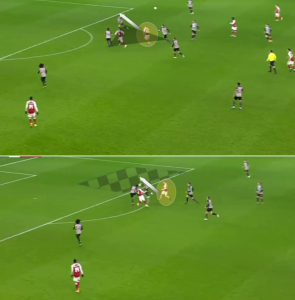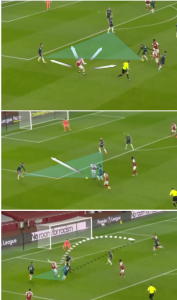The Future of Arsenal: Emile Smith Rowe
Emile Smith Rowe was ten when he joined Arsenal FC. He was a professional player by seventeen. Now twenty-one he is a first-team regular, Premier League standout and England international.
As Arsenal move towards a new era under Mikel Arteta, one where youth and the kind of energy and enthusiasm that often accompanies youth is king, Arsenal’s young attacking midfielder is a key component.
This analysis will detail the player Smith Rowe is, the nature of his game, how he typifies an ideal that Arteta and the club are working towards, and ultimately why he is so impressive.
This is one part of a series exploring the future of Arsenal.
Positional play
Emile Smith Rowe is a right-footed attacking midfielder. How attacking his midfield role actually is tends to depend on the team Arsenal face up against. He can be found as high up the pitch as a left wing forward – as he usually is when representing his country – and as deep as right midfield – as he was when Arsenal faced Burnley earlier in the season.

Smith Rowe is comfortable through defensive to offensive transitions and his willingness to cover ground lends really well to a degree of versatility in his positional game.
While he is naturally gifted in offensive aspects, his attitude and approach to the game mean he offers just as much in defensive situations.
Under Arteta, there is plenty of defensive responsibility for the offensive players. The pressing in advanced areas isn’t utilised universally, at least not yet, Arsenal are still cautious out of possession against the league’s more dangerous teams, but there is evidence that the team is becoming more accustomed to the high energy, high-intensity game off the ball.
Emile Smith Rowe is one of the central components within this idea.
He can play through either flank as well as through the central channel, and he likes to play inside half-spaces in order to find and use spaces between opposition markers. Smith Rowe is more likely to drop off into space between midfield and defensive lines than he is to run off the shoulder of the last defender. He is more in the creative mold than the direct offensive one.
We will see illustrated how Smith Rowe’s technical game – namely the dribbling, passing and shooting – highlights his use of space and his positional habits.
For a player so young, and with so few appearances against the real elite, Smith Rowe demonstrates the initial foundations for excellent positional sense. His intellectual game is generally already really strong and on top of this he possesses great potential for further improvement in this key, invaluable aspect of play.
Vision, passing, chance creation
Emile Smith Rowe isn’t a high volume creator of chances, at least not yet. The Arsenal unit he is a part of have typically struggled with chances and goals since Smith Rowe established himself within the team.
Over the course of the 2020/21 Premier League season, Arsenal accumulated an xG value of 52.3 and scored 55 goals. A total bettered by ten and nine teams respectively. Smith Rowe accumulated xA value across the season (approximately 1500 minutes on the pitch) was 3.6 – the third highest in the squad.
The xG accumulated by Arsenal after 20 games of the current (2021/22) season (32.8) puts only four teams ahead of them; there are five ahead of them in terms of actual goals scored (33). Things appear to be improving in the offensive third for Arsenal. Smith Rowe is again the third-highest ranked for xA – this time with 2.2 after approximately 1300 minutes.
Statistically, Smith Rowe is creating about as much as we can expect from a player of his profile, age, as well as the team he plays within.
I’ve compiled a few of the key passes, assists, more progressive passes over the past few years to illustrate that, even without output and raw numbers right now, the capability is there, and there is a good reason why the player still hovers amongst the best creators in a squad that struggles to create a lot of high-quality chances.
Across all competitions this season, Emile Smith Rowe has maintained pass accuracy of 90% (from 40 passes per 90), long passes are 59% (0.8), through passes 47% (0.8) and crosses – a metric that always presents relatively low percentages, regardless of who is playing them – stand at 26% accurate (1.4).
The passing is comfortable, the accuracy consistent and generally effective. The key metrics here, however, are my personal favourites when looking at attacking midfielders who operate between lines and in half-spaces: passes into the final third and passes into the penalty area.
With 3.4 passes into the opposition defensive third, Smith Rowe is finding an Arsenal player 87% of the time. From 2.7 passes played into the opposition penalty area, a teammate is found 58% of the time. It’s impressive.
Not only is it impressive, but it is also, apparently, sustainable too. Smith Rowe’s passing accuracy to the final third has increased by only 7% since the previous season. And his accuracy for passes into the opposition penalty area has actually decreased from 62%. However, the frequency of these passes has understandably increased since 2020/21 – these were 2.6 and 1.8 respectively.

Smith Rowe is finding these positions more often, feeling comfortable to play those high risk passes more often, and the accuracy hasn’t waned.
The difference between a player who can create a lot of chances and a player who does create a lot of chances is often linked to the players around him – the pass receivers.
Once Arsenal become better in their attacking movements, Smith Rowe – as one of the creative inputters – is likely to be at the centre of that. The capability is there; the application, currently, is not. At least not with any real consistency.
Smith Rowe is very strong at identifying useful spaces in key areas, he has a natural aptitude in picking the right pass and executing it without hesitation; what he doesn’t yet have is options to pick out. The runs aren’t always there, the spaces aren’t always being used optimally by teammates.
It’s normal, and it isn’t really an issue for the team currently. It is best to lay foundations from the ground up, and that means assessing and improving your defensive game, your midfield coverage, and your off-the-ball game before working on fine-tuning offensive movements.
Attacking football comes last, and it will be at that point when Smith Rowe and his natural ability to manipulate the ball within the scope of chance creation will shine.
Control, agility, dribbling
Emile Smith Rowe was described as “silky” by Huddersfield Town first-team coach Mark Hudson when the player joined the West Yorkshire club on loan. I think that’s an appropriate adjective. There is a smoothness about the way Smith Rowe receives the ball in his stride on the half-turn and then accelerates.
I’ve compiled a few examples of this to highlight how it translates to Smith Rowe’s ability in 1 v 1 duels and his identification of open space.
All good actions on the ball start with the right first touch. Whether it’s close control into the body, a longer touch into space, a pass, shot, whatever; the first touch sets the player on course for an effective second one. Emile Smith Rowe possesses an excellent close control first touch.
He can receive the ball at full stride and cushion his control. This allows Smith Rowe to adapt his next move optimally. When the ball is fully under control the player can go left, right, forward or backward; he is fully in control of where he goes and what he does with the ball.
Having placed the ball under his control, the important factors then become a matter of decisions and physicality.
We’ve already seen the spaces Smith Rowe likes to occupy and his movement with the ball at his feet fit within this.
He is a direct runner, he likes to dribble at players, creating 1 v 1 situations. If a player is isolated with space open beyond him, Smith Rowe regularly attempts the dribble. There have been 3.5 of these per 90 during the current season, up from 2.8 the season before. 48% and 50% accuracy respectively.
Having identified the space and decided upon moving into it, it is the agility of Smith Rowe that allows him to break into spaces and successfully evade his defender.
Mark Hudson explained that Smith Rowe “doesn’t look quick” but he “naturally glides with the ball”. It’s another good way to describe Smith Rowe’s style.
I’ve explored players who move this way before – agile movers rather than powerful runners or sprinters. Smith Rowe isn’t slow but neither is he a natural athlete in his raw pace. He covers ground quickly with intelligent movements. Short strides keep the ball under control, rapid changes in direction prevent interceptions, bursts of acceleration cover the vital first few yards quick enough to move into those key advanced spaces.
When there are clear and open spaces ahead of Smith Rowe, he isn’t afraid to stretch his legs, but this isn’t exactly the kind of dribbler he is. Silky, not speedy. The bottom line for Emile Smith Rowe is the identification, occupation and use of spaces. His movement style and manner of dribbling or carrying the ball cater towards that.
Shooting, finishing, scoring goals
Emile Smith Rowe isn’t an instinctive goalscorer, he doesn’t find himself in positions to score very often. If we’re categorising him as one or the other, Smth Rowe sits comfortably on the creative and supportive side of things. That doesn’t mean he isn’t adept at finding the net, however.
From 35 shots taken this season, Smith Rowe has scored 11 goals. 63% of those shots were on target, 31% were scored. It’s a short sample, and I wouldn’t suggest it marks Smith Rowe as the world-class finisher those percentages might indicate under other circumstances, but it does point towards a player with clean technique and an understanding of proper shot accuracy when the need arises.
Many of Smith Rowe’s shot openings come after a supporting run behind the forwards or ‘main’ attackers. We’ve seen his preference for occupying spaces behind the attack, dropping off the defensive line, and these spaces offer the option to move wide of the advanced forwards to provide an option in space. Smith Rowe’s extra-time goal against Newcastle in the FA cup was a good example of this.

The finish itself was also expert on that occasion. The chest control – further illustrative of Smith Rowe’s superb first touch – took the ball away from covering defenders and set it perfectly into his stride, his volley finish was perfectly timed and executed. He gave himself the best chance at controlling the shot on his terms and, as a result, he found the net via the inside of the far post. A brilliant finish.
Smith Rowe takes great care of the ball. That is a staple of his game. He isn’t necessarily a high-risk attacking midfielder, attempting long-range strikes or line-breaking long passes – though when he does, he often does so to good effect – rather Smith Rowe is a considered and thoughtful attacking midfielder.
If there is a shot taken from 20 yards, it is taken with the ball under control. If there is an intricate piece of forward play, it comes after Smith Rowe has created for himself – either on the ball with a good touch or off the ball with good movement – the likelihood that it will be executed successfully.
There is room for Smith Rowe to develop stronger, more ruthless instincts in front of goal. He is capable of exerting the kind of situational control over the ball needed to score regularly. But at the moment, Smith Rowe is comfortable in his more auxiliary role. Smith Rowe currently supports offensive play, he doesn’t lead it.
Anticipation, work rate, ball recovery
One of the most significant aspects of Arsenal’s game when at their best under Mikel Arteta is their aggression in the press. Especially their pressing from midfield to offensive thirds. Arsenal’s (mostly) young, energetic, determined strikeforce can be very effective at this and Emile Smith Rowe is a central figure.
While he moves quickly, Smith Rowe isn’t eating up yards like a sprinter. But he does cover the ground aggressively and with good determination. This season, Emile Smith Rowe, along with Bukayo Saka and Gabriel Martinelli, are committing to pressures and tackles like defenders in the middle and attacking thirds.
And in Smith Rowe’s case, this isn’t blind and aimless aggression. He has great positional anticipation and demonstrates the potential to be an expert ‘presser’. I’ve compiled a few of his interceptions to illustrate this.
Recovering the ball this way – by anticipating the opposition movement or passing lane – can be vital in forcing turnovers in high-value situations, initiating counter-attacks, and, coupled with Smith Rowe’s ability to cover ground quickly and with great control over the ball, catering to high-quality transitional football.
There was a good example of this anticipation and positional play in Arsenal’s 4-2 win over Leeds United.
With Leeds in p ossession, Smith Rowe primes himself to receive the ball between lines if his teammate (Cédric Soares 17) is able to win possession.
ossession, Smith Rowe primes himself to receive the ball between lines if his teammate (Cédric Soares 17) is able to win possession.
Soares makes the challenge, recovers the ball, and Smith Rowe is perfectly placed to carry the ball directly between defenders into the penalty area.
Smith Rowe plays a super pass to Aubameyang at the far post who completes a hat trick.
It’s a good example of how off-the-ball anticipation and positional understanding – essentially a defensive action – can be used to great effect in offensive situations.
Emile Smith Rowe is heading towards becoming a very effective ‘defensive attacker’, a role so famously and brilliantly performed by Liverpool’s Roberto Firmino.
Emile Smith Rowe
He’s an interesting player. There is a degree of nuance in Smith Rowe that makes his style of play both aesthetically pleasing and consistently effective.
He possesses great control naturally and this is an attribute that can act as foundation to so many of the game’s most difficult aspects. If the ball is under control, dribbling, passing, shooting – even in high pressured or high-risk situations – become far less volatile and far more reliable.
There is still a lot of development and fine-tuning ahead of Smith Rowe, not just within himself as a 21-year-old playing at the elite level, but also within his place in a team that is still finding its own identity under a young manager with his own ideas and plans.
The player Emile Smith Rowe is right now – the calm, composed, “silky” attacking midfielder who always maintains control over the ball and himself, who “glides” and creates and scores – is enough to warrant the opinion that this is a serious player on the European stage. The player that Emile Smith Rowe could become over the next three to four years is a truly exciting prospect.
Excellent now and only getting better.


